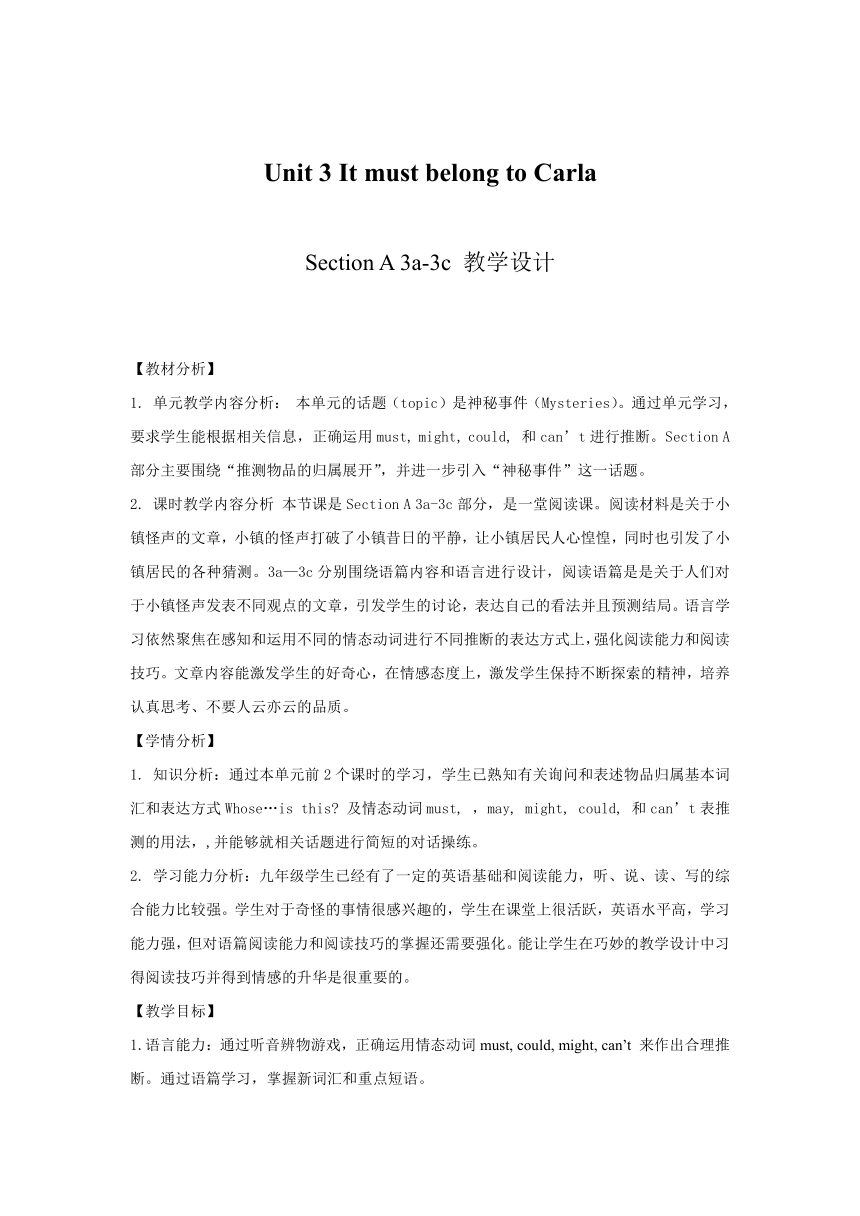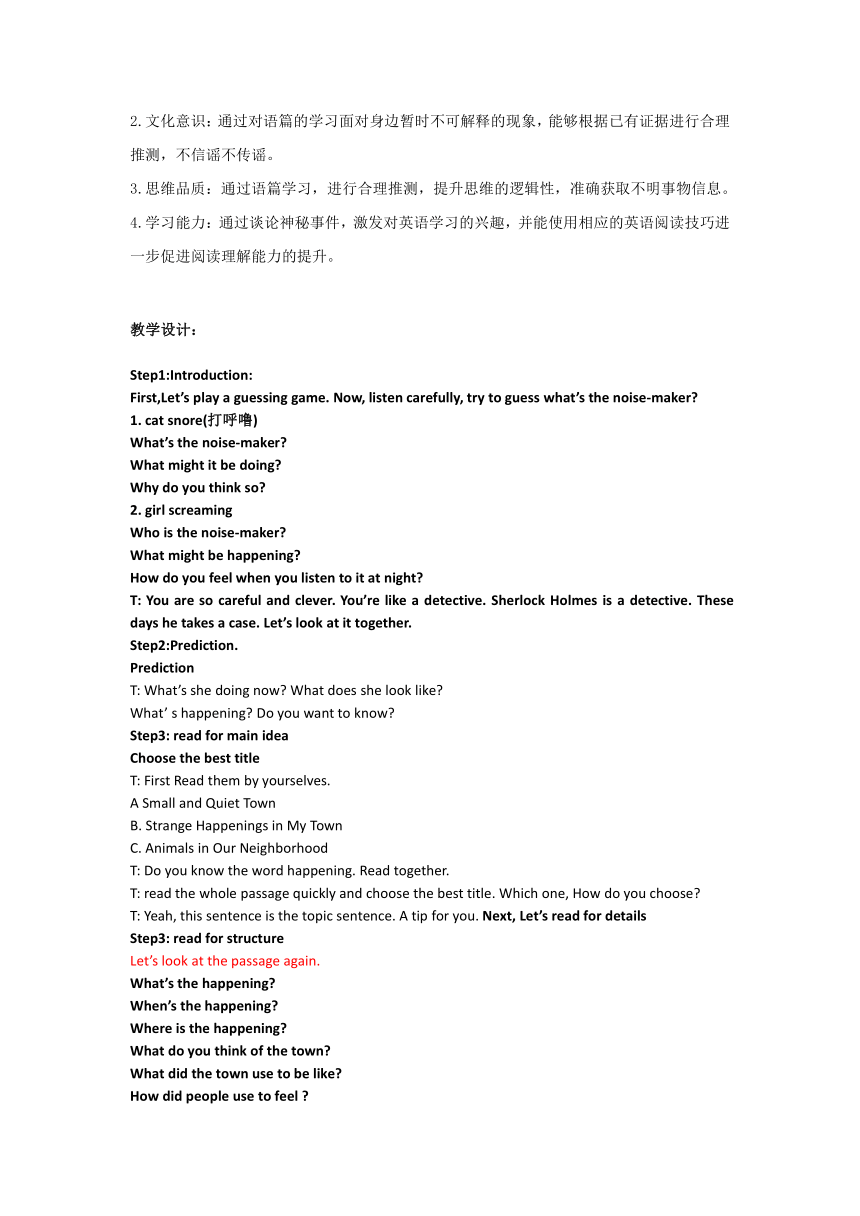Unit 3 It must belong to Carla.A 3a-3c 教学设计 鲁教版(五四制)英语九年级全册
文档属性
| 名称 | Unit 3 It must belong to Carla.A 3a-3c 教学设计 鲁教版(五四制)英语九年级全册 |

|
|
| 格式 | doc | ||
| 文件大小 | 787.8KB | ||
| 资源类型 | 教案 | ||
| 版本资源 | 鲁教版 | ||
| 科目 | 英语 | ||
| 更新时间 | 2024-03-01 20:47:06 | ||
图片预览


文档简介
Unit 3 It must belong to Carla
Section A 3a-3c 教学设计
【教材分析】
1. 单元教学内容分析: 本单元的话题(topic)是神秘事件(Mysteries)。通过单元学习,要求学生能根据相关信息,正确运用must, might, could, 和can’t进行推断。Section A 部分主要围绕“推测物品的归属展开”,并进一步引入“神秘事件”这一话题。
2. 课时教学内容分析 本节课是Section A 3a-3c部分,是一堂阅读课。阅读材料是关于小镇怪声的文章,小镇的怪声打破了小镇昔日的平静,让小镇居民人心惶惶,同时也引发了小镇居民的各种猜测。3a—3c分别围绕语篇内容和语言进行设计,阅读语篇是是关于人们对于小镇怪声发表不同观点的文章,引发学生的讨论,表达自己的看法并且预测结局。语言学习依然聚焦在感知和运用不同的情态动词进行不同推断的表达方式上,强化阅读能力和阅读技巧。文章内容能激发学生的好奇心,在情感态度上,激发学生保持不断探索的精神,培养认真思考、不要人云亦云的品质。
【学情分析】
1. 知识分析:通过本单元前2个课时的学习,学生已熟知有关询问和表述物品归属基本词汇和表达方式Whose…is this 及情态动词must, ,may, might, could, 和can’t表推测的用法,,并能够就相关话题进行简短的对话操练。
2. 学习能力分析:九年级学生已经有了一定的英语基础和阅读能力,听、说、读、写的综合能力比较强。学生对于奇怪的事情很感兴趣的,学生在课堂上很活跃,英语水平高,学习能力强,但对语篇阅读能力和阅读技巧的掌握还需要强化。能让学生在巧妙的教学设计中习得阅读技巧并得到情感的升华是很重要的。
【教学目标】
1.语言能力:通过听音辨物游戏,正确运用情态动词must, could, might, can’t 来作出合理推断。通过语篇学习,掌握新词汇和重点短语。
2.文化意识:通过对语篇的学习面对身边暂时不可解释的现象,能够根据已有证据进行合理推测,不信谣不传谣。
3.思维品质:通过语篇学习,进行合理推测,提升思维的逻辑性,准确获取不明事物信息。
4.学习能力:通过谈论神秘事件,激发对英语学习的兴趣,并能使用相应的英语阅读技巧进一步促进阅读理解能力的提升。
教学设计:
Step1:Introduction:
First,Let’s play a guessing game. Now, listen carefully, try to guess what’s the noise-maker
1. cat snore(打呼噜)
What’s the noise-maker
What might it be doing
Why do you think so
2. girl screaming
Who is the noise-maker
What might be happening
How do you feel when you listen to it at night
T: You are so careful and clever. You’re like a detective. Sherlock Holmes is a detective. These days he takes a case. Let’s look at it together.
Step2:Prediction.
Prediction
T: What’s she doing now What does she look like
What’ s happening Do you want to know
Step3: read for main idea
Choose the best title
T: First Read them by yourselves.
A Small and Quiet Town
B. Strange Happenings in My Town
C. Animals in Our Neighborhood
T: Do you know the word happening. Read together.
T: read the whole passage quickly and choose the best title. Which one, How do you choose
T: Yeah, this sentence is the topic sentence. A tip for you. Next, Let’s read for details
Step3: read for structure
Let’s look at the passage again.
What’s the happening
When’s the happening
Where is the happening
What do you think of the town
What did the town use to be like
How did people use to feel
But how do people feel now
Why Everyone can hear strange noise. Who’s the noise-maker Who heard the noise
Step4: Scanning
T: Now read the passage again and circle the people who heard the noise. Let’s circle together.
T: What are their opinions Now, read the passage again and fill in the blanks.
Let’s check answers.(边让学生回答,边张贴, 注意原因在左,观点在右)
T: What is the writer’s opinion Can you find the writer’s opinion about the noise-maker
Read the passage and try to find it.
T: Everyone has his or her own ideas, are they reasonable?
T: So…
T: Does the noise-maker want to leave Why
Step 5: Thinking:
T: Among these people, who is the most believable And why
Who is the least believable And why?Please discuss in groups. A tip for you.
Step 6: Thinking2:
T: Did they see the noise-maker. So they are making inferences about who the noise-maker is.
T: How can we make inferences, first, we should give the reasons(贴贴纸), If you want others believe you, you need to tell them What you see, What you hear and What you find.
T: Then, we will give our opinions. (贴贴纸)。 How to give opinions, first people, then think, guess, then our opinion.
We need to put them together.
Who’s the noise- maker, what’s your opinion
Step 7: Interview
Imagine(假设) you live in the neighborhood, too. Holmes wants to know about your ideas. Three in a group, one is Holmes, the other two need to tell your own opinions to Holmes.
An example for you. Read by yourselves.
When you’re ready, please come here and perform your dialogue.
(学生上台时) Everyone has a chart and you need to score it.
Step8: An ending for the happening
If you were Holmes. After several days’ of investigation (调查),you have found out the truth, please tell people the truth with three or four sentences.
Step9: T: When we face strange things, what should we do
Step5: Scanning:
Who heard the noise Read the article and find them
What are their opinions Read the passage and underline their opinions and match person with the pictures.
Now fill in the blanks. And check answers.
Why do they think so Now finish the chart and check answers.
Step6: Post-reading
Now I have a question:
Do you think which one is the most believable Why
Which one is the least believable Why
Tips:
Facts(事实,证据)are important. If you want others to believe you, you need to tell them What you see, what you hear and what you find.(出示Helen和one woman的理由)
When you give inference, don’t forget could,might,can’t, must.
Step6: Interview.
Four students in a group, one is the reporter, the other three can be Victor, Victor’s wife, the policeman, Helen, one woman, or the writer. The reporter is from the town newspaper. He wants to learn about the happening and now he is interviewing the neighbors. You can begin the dialogue like this:
Reporter: Miss Helen, Do you think who is the noise-maker
Helen: I think it can’t be a dog
Reporter: Why do you think so
Helen:...
Reporter: Mr Victor, Do you think who is the noise-maker
...
Step7: writing
Who do you think is the noise-maker. Do you have other guesses You can choose one to make inferences. Don’t forget the facts and could,might, can’t and must.
Step8: Homework
Section A 3a-3c 教学设计
【教材分析】
1. 单元教学内容分析: 本单元的话题(topic)是神秘事件(Mysteries)。通过单元学习,要求学生能根据相关信息,正确运用must, might, could, 和can’t进行推断。Section A 部分主要围绕“推测物品的归属展开”,并进一步引入“神秘事件”这一话题。
2. 课时教学内容分析 本节课是Section A 3a-3c部分,是一堂阅读课。阅读材料是关于小镇怪声的文章,小镇的怪声打破了小镇昔日的平静,让小镇居民人心惶惶,同时也引发了小镇居民的各种猜测。3a—3c分别围绕语篇内容和语言进行设计,阅读语篇是是关于人们对于小镇怪声发表不同观点的文章,引发学生的讨论,表达自己的看法并且预测结局。语言学习依然聚焦在感知和运用不同的情态动词进行不同推断的表达方式上,强化阅读能力和阅读技巧。文章内容能激发学生的好奇心,在情感态度上,激发学生保持不断探索的精神,培养认真思考、不要人云亦云的品质。
【学情分析】
1. 知识分析:通过本单元前2个课时的学习,学生已熟知有关询问和表述物品归属基本词汇和表达方式Whose…is this 及情态动词must, ,may, might, could, 和can’t表推测的用法,,并能够就相关话题进行简短的对话操练。
2. 学习能力分析:九年级学生已经有了一定的英语基础和阅读能力,听、说、读、写的综合能力比较强。学生对于奇怪的事情很感兴趣的,学生在课堂上很活跃,英语水平高,学习能力强,但对语篇阅读能力和阅读技巧的掌握还需要强化。能让学生在巧妙的教学设计中习得阅读技巧并得到情感的升华是很重要的。
【教学目标】
1.语言能力:通过听音辨物游戏,正确运用情态动词must, could, might, can’t 来作出合理推断。通过语篇学习,掌握新词汇和重点短语。
2.文化意识:通过对语篇的学习面对身边暂时不可解释的现象,能够根据已有证据进行合理推测,不信谣不传谣。
3.思维品质:通过语篇学习,进行合理推测,提升思维的逻辑性,准确获取不明事物信息。
4.学习能力:通过谈论神秘事件,激发对英语学习的兴趣,并能使用相应的英语阅读技巧进一步促进阅读理解能力的提升。
教学设计:
Step1:Introduction:
First,Let’s play a guessing game. Now, listen carefully, try to guess what’s the noise-maker
1. cat snore(打呼噜)
What’s the noise-maker
What might it be doing
Why do you think so
2. girl screaming
Who is the noise-maker
What might be happening
How do you feel when you listen to it at night
T: You are so careful and clever. You’re like a detective. Sherlock Holmes is a detective. These days he takes a case. Let’s look at it together.
Step2:Prediction.
Prediction
T: What’s she doing now What does she look like
What’ s happening Do you want to know
Step3: read for main idea
Choose the best title
T: First Read them by yourselves.
A Small and Quiet Town
B. Strange Happenings in My Town
C. Animals in Our Neighborhood
T: Do you know the word happening. Read together.
T: read the whole passage quickly and choose the best title. Which one, How do you choose
T: Yeah, this sentence is the topic sentence. A tip for you. Next, Let’s read for details
Step3: read for structure
Let’s look at the passage again.
What’s the happening
When’s the happening
Where is the happening
What do you think of the town
What did the town use to be like
How did people use to feel
But how do people feel now
Why Everyone can hear strange noise. Who’s the noise-maker Who heard the noise
Step4: Scanning
T: Now read the passage again and circle the people who heard the noise. Let’s circle together.
T: What are their opinions Now, read the passage again and fill in the blanks.
Let’s check answers.(边让学生回答,边张贴, 注意原因在左,观点在右)
T: What is the writer’s opinion Can you find the writer’s opinion about the noise-maker
Read the passage and try to find it.
T: Everyone has his or her own ideas, are they reasonable?
T: So…
T: Does the noise-maker want to leave Why
Step 5: Thinking:
T: Among these people, who is the most believable And why
Who is the least believable And why?Please discuss in groups. A tip for you.
Step 6: Thinking2:
T: Did they see the noise-maker. So they are making inferences about who the noise-maker is.
T: How can we make inferences, first, we should give the reasons(贴贴纸), If you want others believe you, you need to tell them What you see, What you hear and What you find.
T: Then, we will give our opinions. (贴贴纸)。 How to give opinions, first people, then think, guess, then our opinion.
We need to put them together.
Who’s the noise- maker, what’s your opinion
Step 7: Interview
Imagine(假设) you live in the neighborhood, too. Holmes wants to know about your ideas. Three in a group, one is Holmes, the other two need to tell your own opinions to Holmes.
An example for you. Read by yourselves.
When you’re ready, please come here and perform your dialogue.
(学生上台时) Everyone has a chart and you need to score it.
Step8: An ending for the happening
If you were Holmes. After several days’ of investigation (调查),you have found out the truth, please tell people the truth with three or four sentences.
Step9: T: When we face strange things, what should we do
Step5: Scanning:
Who heard the noise Read the article and find them
What are their opinions Read the passage and underline their opinions and match person with the pictures.
Now fill in the blanks. And check answers.
Why do they think so Now finish the chart and check answers.
Step6: Post-reading
Now I have a question:
Do you think which one is the most believable Why
Which one is the least believable Why
Tips:
Facts(事实,证据)are important. If you want others to believe you, you need to tell them What you see, what you hear and what you find.(出示Helen和one woman的理由)
When you give inference, don’t forget could,might,can’t, must.
Step6: Interview.
Four students in a group, one is the reporter, the other three can be Victor, Victor’s wife, the policeman, Helen, one woman, or the writer. The reporter is from the town newspaper. He wants to learn about the happening and now he is interviewing the neighbors. You can begin the dialogue like this:
Reporter: Miss Helen, Do you think who is the noise-maker
Helen: I think it can’t be a dog
Reporter: Why do you think so
Helen:...
Reporter: Mr Victor, Do you think who is the noise-maker
...
Step7: writing
Who do you think is the noise-maker. Do you have other guesses You can choose one to make inferences. Don’t forget the facts and could,might, can’t and must.
Step8: Homework
同课章节目录
- Unit 1 When was it invented?
- Section A
- Section B
- Unit 2 Teenagers should be allowed to choose their
- Section A
- Section B
- Unit 3 It must belong to Carla.
- Section A
- Section B
- Unit 4 I like music that I can dance to.
- Section A
- Section B
- Unit 5 You’re supposed to shake hands.
- Section A
- Section B
- Unit 6 Sad movies make me cry.
- Section A
- Section B
- Unit 7 Life is full of the unexpected.
- Section A
- Section B
- Unit 8 We're trying to save the earth!
- Section A
- Section B
- Unit 9 It's important to have good habits.
- Section A
- Section B
- Unit 10 I remember meeting all of you in Grade 6.
- Section A
- Section B
